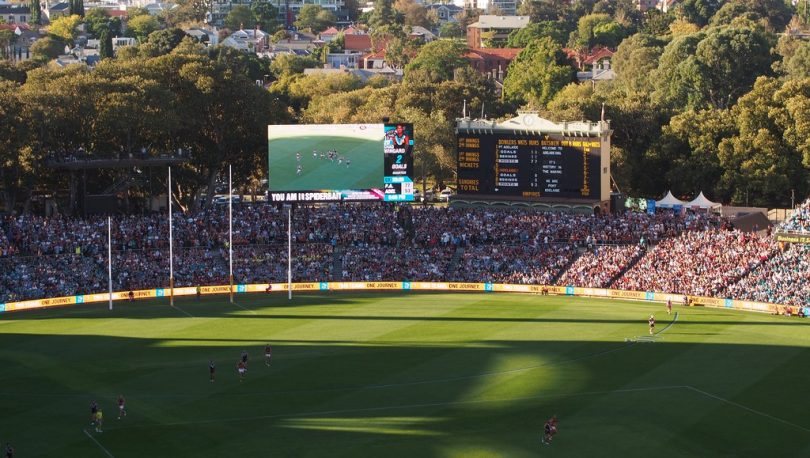Mediated sport has the innate ability to unify peoples within and between societies, and is important for the health of the citizenry.
It is no secret that the AFL is one of the most widely followed sports in the country with 7.5 million Australians aged 14+ (36%) having watched AFL matches on TV in 2020.
But the lack of diversity in the people who report upon football is not helping the sport’s cause as a tool of social cohesion.
Lack of diversity in Australian media
A report by Media Diversity Australia in 2020 uncovered that more than 75 per cent of presenters, commentators and reporters have an Anglo-Celtic background, while only 6 per cent of presenters, commentators and reporters have either an Indigenous or non-European background.
The report also noted that 70 per cent of participants rated the representation of culturally diverse men and women as poor or very poor.
In addition, 77 per cent of respondents with diverse backgrounds believed having a diverse cultural background was a barrier to career progression
Sports media notoriously resonates with this.
Under-representation in football media
In the 2016 Census, Indigenous Australians made up 2.8% of the population, but Indigenous footballers make up 11% of the AFL playing cohort.
Traditional mainstream football media does not adequately represent the 87 Indigenous footballers that are actually playing in the AFL.
There is not a single full-time AFL commentator with an Indigenous background working in commercial TV.
The popular Marngrook Footy show, which was aired on NITV, was axed for budgetary reasons in 2019.
It has has been left to the well-resourced AFL to part fund the new Yokayi Footy Show on their website, which is broadcast through AFL Media.
By the same token, there are over 200 players across both the AFL and AFLW who were born overseas or have a parent born overseas.
Again, it has been left to the resources of AFL to establish initiatives like multicultural round, promoted through AFL Media.
Meet Frankie – AFL Multicultural Round
Celebrating AFL Diversity – Many cultures, one game. For more video, head to http://afl.com.au
What impact would diverse voices have?
Our national code would be far more representative of the make-up of the country.
AFL chief of inclusion and social policy Tanya Hosch said “what is really clear is if we are going to progress as a football code then all of the different perspectives need to start being represented”.
The lack of Indigenous Australians commentating on Australian rules football in the mainstream media is alarming.
Former AFL footballer Andrew Krakouer said “with all the amazing talent among Aboriginal players and the way they see the game, they can provide something different with their knowledge of the game and just being an Indigenous person”.
The football media also has a responsibility with big, sensitive societal issues and the Adam Goodes booing episode arguably would have been handled differently.
Throughout the saga, evidenced by The Final Quarter documentary, it is clear that not enough Indigenous people were sought out for their views, which would have provided a more rounded perspective.
The documentary was compiled entirely from existing excerpts from the media.
“lll-informed and ignorant comments were made by people who couldn’t empathise and seemed too set in their ways to open their minds to other views,” Krakouer said.
We would deal with issues better as a football community with the enlightenment of more diverse voices.
AFL diversity consultant Rana Hussain wants to appeal to marginalised communities through her work as a writer and broadcaster.
As a young Muslim fan, Hussain realised Australian rules football was not the most accessible sport for marginalised communities.
She said having someone to identify with in the media would “help others to feel like they can join the footy culture without having to change who they are”.
Can Australian rules football learn from other sports?
Yes, from soccer (also known as the real football).
There is no need to look any further than the late Les Murray, who became a pioneer in sports broadcasting in Australia after arriving as a refugee from Hungary in the 1950s.
Albeit a different dynamic given soccer’s status as “the world game”, Murray still transformed soccer from a migrant activity into a mainstream sport in Australia.
A Les Murray Tribute
We’re going to miss Les Murray enormously around SBS, as we’re sure you will, too. So as his final World Cup wraps up, here is our video tribute to Mr Footba…
An identity within soccer was integral to new migrants and multiculturalism in Australia at that time.
Les spoke highly of his fundamental role as a broadcaster to tell their stories through soccer, what he called “the beautiful game”.
His role as the face of soccer in Australia brought people together all across the Australian landscape and he is rightfully attributed to playing a big part in the evolution of multiculturalism in Australia.
(Feature Image: Showdown at the Adelaide Oval, 29/03/2014 credit: Adriano Rotolo on Flickr)





Those statistics are quite alarming, particularly about the number of Indigenous players – and none commenting on commercial networks. That seems wrong on so many levels.
Excellent article, Casey. The statistics cited are disconcerting but sadly not surprising given Australia’s history and its predominantly white cultural makeup. The lack of ethnic or racial diversity within sports media is an example of what British journalist Reni-Eddo Lodge calls ‘structural racism’. It’s a form of racism which is not nakedly obvious to the eye — like that of the 13 year old girl who called Adam Goodes an ‘ape’ — but rather covert and almost invisible. As the recent Collingwood ‘Do Better’ report showed, there is great deal more AFL clubs can and should do to dismantle racism. But the task does not only belong to them. As your article points out, the media clearly has a part to play — perhaps even more so given the privileged and powerful position it occupies to influence public debate. Increasing diversity within the media, whether by quotas or other means, is surely the most obvious first step.
Wow, how about that 36 per cent stat! What an influence the game has in Australia.
Yokayi on AFL On Demand is pretty good. I do really like Armstrong and Megan Waters. Their contribution to the footy media landscape this year has been really great – but obviously they’re just on the app and not commentating on the main channels, so that’s an issue. I’m still very flat that the Marngrook Footy Show left us in 2019.
I’m quite concerned that not enough is being done in the footy media to rectify the unbalanced colonial image of the sport. I’m sick of hearing James Brayshaw and Brian Taylor speak about ‘The Geelong Grammar football factory’ or a ‘young Western districts boy’ from ‘good stock’. I think it proves just how insular their worlds are. There was a good article by Jake Niall in The Age a couple years ago about these issues.
Great article Casey. Those statistics are alarming! There are so many talented Indigenous and multicultural personalities in the AFL who would make fantastic commentators and give a different perspective into the football world.
As Emile mentioned, Tony Armstrong is a former AFL Indigenous player who is doing great things within the media. At one stage, another former Indigenous footballer in Gilbert McAdam was a regular on Channel Seven’s football coverage but unfortunately, he is no longer with the station.
I wonder if the prevalence of online trolling towards Indigenous and multicultural players is having an impact on whether players want to or feel comfortable enough to be involved in the media industry. However, hopefully, in the future we see more diversity within the coverage of all sports, but especially in the AFL.
Thanks for writing about this important issue, Casey. I was shocked to read that 77% of respondents from the Media Diversity Australia report believe having a diverse cultural background is a barrier to career progression.
I do think that a number of organisations are encouraging Indigenous Australians to apply for jobs and to participate in sport. Over the past couple of years, I have seen a few job opportunities and cadetships at the ABC. I wonder how much interest the ABC receive when they advertise these roles. A lot of sporting organisations also have their own participation and diversity and inclusion teams. There are a lot of programs that have been designed across all sports to empower and create opportunities for Indigenous students.
One way that the AFL can encourage retired Indigenous footballers to commentate could be to create a similar program and to mentor and train them. This could instil confidence in them and encourage other Indigenous athletes to work in sports media. It could be a starting point for Australia to have more diverse voices in the AFL.
What a wonderful article! Great job Casey, I really enjoyed reading this.
I agree, there definitely needs to be more diverse voices in AFL, particularly indigenous voices.
I also feel this draws attention to the importance of cultural awareness and more specifically media training in the AFL to ensure ex-Indigenous AFL players are included/guided into the process of being a commentator.
Perhaps, with relevant training which focuses on AFL players with particular cultural backgrounds the AFL can continue to diversify its commentary mix.
11% of the playing cohort coming from an Indigenous background but not a single Indigenous reporter! Truly an eye-opening and great article, Casey. Not only is it a fail for diversity but also for getting some new voices in the mix – players make such great commentators. But it’s understandable why Indigenous players or reporters might not want to align themselves with the AFL after how Adam Goodes was treated. The diversity consultants, like Rana Hussain, certainly have their work cut out for them… Thanks for this article!
Great article Casey! The statistics on the lack of diversity in the media are incredibly damning. The situation is even worse in the AFL media, given how often ex-players are gifted cushy media jobs following their careers. I can’t help feeling that a more diverse AFL media, including increased Indigenous representation, would be more willing to tackle stories around cultural issues in sport that are currently often ignored. This would also alleviate the perception of sports journalism as the ‘toy department’ that you and Tash spoke about in your presentation.
Your piece reminded me of comments made by journalist Gideon Haigh on the ABC’s sport program Outsiders speaking on why claims of racism by former Collingwood player Hertier Lumumba, ultimately vindicated by the Do Better report, failed to gain traction in the AFL media. Gideon Haigh said that the media widely bought into Collingwood’s attempts to discredit Lumumba “because of their need for access, because of their general conformity and, frankly, their whiteness”. Increased diversity in the media would help give more credence to these stories.